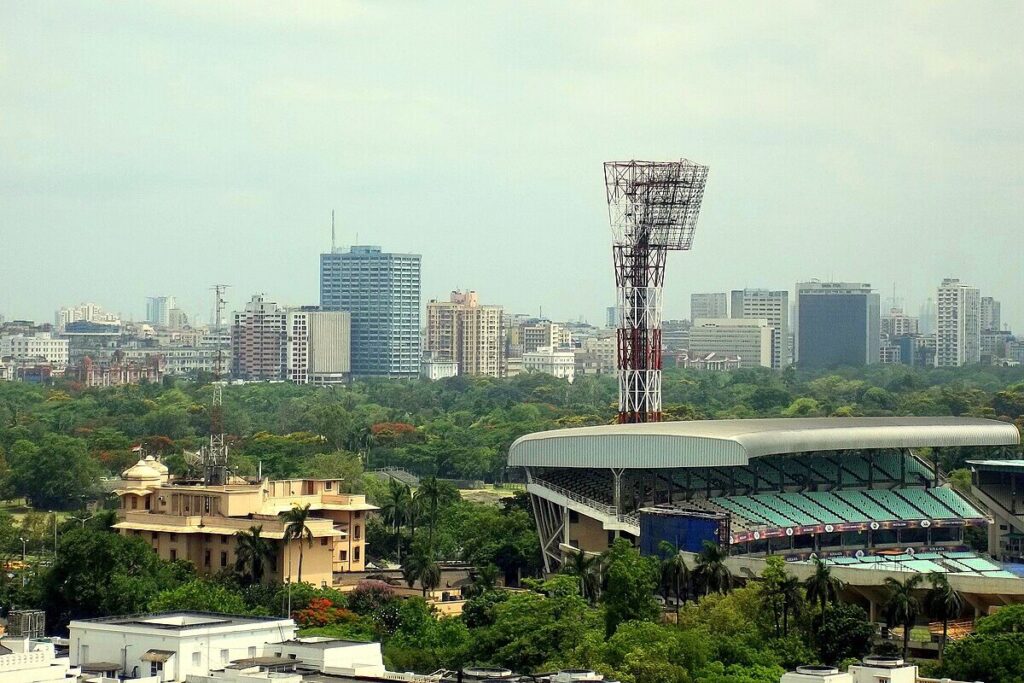
Kolkata is the cultural and economic hub of East India.
1. City Overview
- Population: As of 2025, the urban agglomeration (Greater Kolkata Metro) population is approximately 15.85 million, with an annual growth rate of 1.76%. The city administrative area population is about 4.5 million.
- Area: The city administrative area covers approximately 206 km², with a population density of about 24,000 people/km².
- Languages: The official language is Bengali, and English is widely used. Various minority Indian languages also coexist.
- Religion: Predominantly Hinduism (78%), followed by Islam (20%), with smaller communities of Christians and Jains.
- Climate: Tropical savanna climate (Aw) with an average annual temperature of 26.8°C. Rainfall is concentrated during the monsoon season, averaging 1,836 mm annually.
2. History
- Early Settlement and Colonial Formation (~1700s): Kolkata began in the 17th century with the merger of three villages, including Sutanuti, leading to the establishment of a fort by the British East India Company. It developed as a colonial center after the Battle of Plassey in 1757.
- British Colonial Capital (1772–1911): From 1772, it served as the capital of colonial India until the capital was moved to Delhi in 1911, after which its administrative importance declined.
- After Independence (1947–Present): Following the partition and mass migration, Kolkata accommodated refugees from Bangladesh. After experiencing instability and economic stagnation, it has been undergoing resurgence in the 21st century, strengthening its urban regeneration and industrial base.


3. Geography
- Location: Kolkata is situated on the eastern bank of the Hooghly River, adjacent to the Ganges Delta.
- Urban Structure: The city comprises an old city center with historical landmarks like the Victoria Memorial and ancient districts, and continues to expand with new towns such as Newtown in the north and south.
4. Culture
- Literary and Artistic Heritage: Kolkata is the birthplace of the Bengali Renaissance, known for its diamonds (referring to cultural gems), painting, and literary traditions. It has produced Nobel laureates such as Rabindranath Tagore and Amartya Sen.
- Festivals: Durga Puja, recognized as a UNESCO intangible cultural heritage, involves the installation of over 3,000 temporary structures (pandals) and contributes significantly to the city’s GDP (2.6%).
5. Environment
- Challenges: The city faces issues of overcrowding, frequent smog and fog, and burdens related to waste and water management.
- Response Strategies: The city has implemented a Climate Action Plan (KCAP), which includes weather observation stations, clean air zones, and slum greening initiatives.
- Climate Features: Kolkata experiences Kal Baisakhi thunderstorms, summer temperatures reaching up to 40°C, and winter lows around 9°C.

6. Economy
- Economic Scale and Industrial Profile: Kolkata has a GDP (PPP) of approximately $220 billion USD, making it the largest economic hub in East India by PPP. Its industries are diverse, including coal, steel, pharmaceuticals, IT, manufacturing, and leather. The economy is characterized by flexible manufacturing and a significant informal labor sector.
- Logistics and Finance: The Port of Kolkata is operational, and the city hosts the headquarters of the Calcutta Stock Exchange (CSE), India’s second-largest stock exchange.
- Investment Environment: Efforts are being made to expand Special Economic Zones (SEZ), IT parks, and logistics hubs.
7. Key Locations
- Historical Landmarks: Prominent historical sites include the Victoria Memorial, Howrah Bridge, Indian Museum, and St. Paul’s Cathedral.
- Modern and Cultural Spaces: Newtown is an IT complex, and the Salt Lake Stadium is a major venue. The city also has areas with a high concentration of universities and galleries.
8. Conclusion
Kolkata is a prominent cultural and commercial center in East India.
- Strengths: Its strengths include its rich history and culture, production of Nobel laureates, festival-driven economy, and strong manufacturing and logistics base.
- Challenges: Key challenges include environmental pollution, traffic congestion, overcrowding, and climate risks.
- Future Strategies: Future strategies involve implementing the Climate Action Plan (KCAP) to enhance urban resilience, expanding green spaces and public transport, establishing clean air zones, fostering a creative economy centered on Durga Puja, and introducing sustainable urban regeneration and smart infrastructure.
